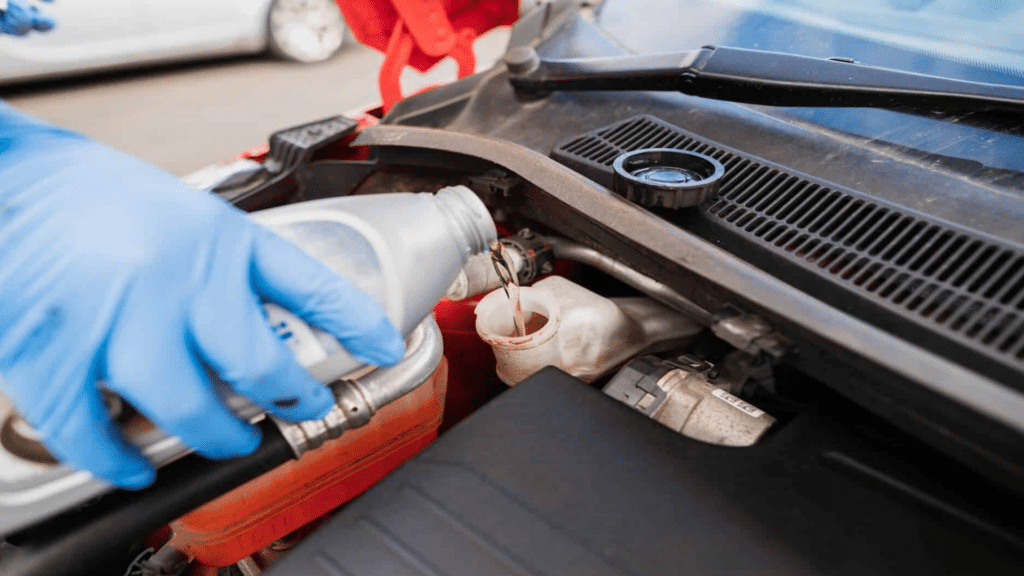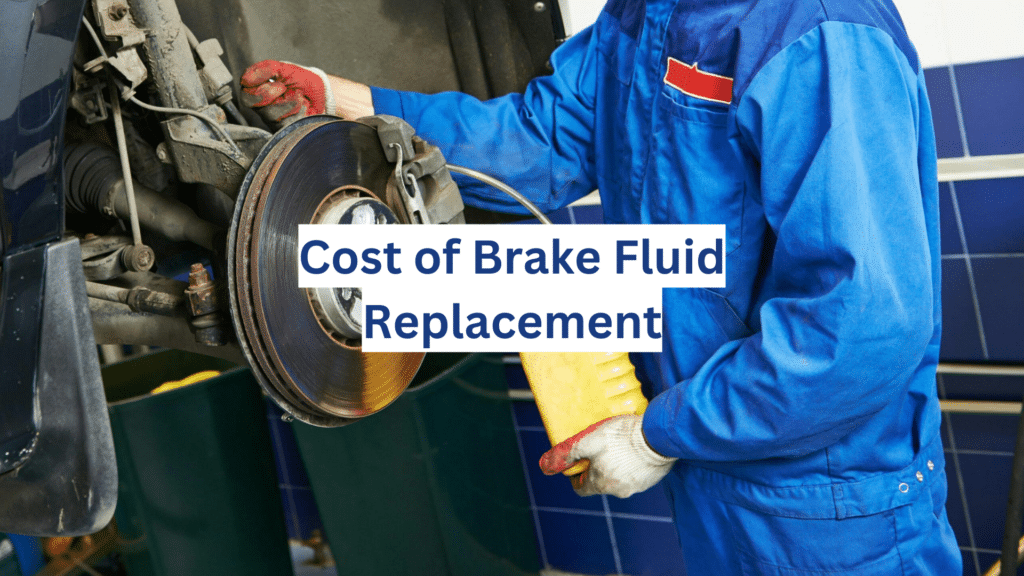Have you ever wondered how much it will cost to replace your brake fluid? If so, you’re in the right place.
In this article, I’ll break down the typical costs of brake fluid replacement across different vehicles and service locations. You’ll learn what factors affect the price and how to know when it’s time for a replacement.
I’ve been a certified mechanic for over 15 years, and I’ve seen countless brake systems. Safety should never be compromised, especially regarding your vehicle’s braking system.
Whether you’re driving a compact car, an SUV, or a luxury vehicle, understanding brake fluid replacement costs helps you:
- Budget for necessary maintenance
- Avoid overpaying at the shop
- Recognize when a quote is fair
Let’s get your questions answered so you can make the best decision for your vehicle and wallet.
What Is Brake Fluid and Why Does It Need Replacement?

Brake fluid is the lifeblood of your braking system. It transfers the force from your foot on the pedal to the brake components that stop your wheels.
Think of it like this: When you press your brake pedal, you push fluid through lines and hoses. This fluid creates pressure that squeezes your brake pads against the rotors.
That friction is what stops your car.
But here’s the problem: Brake fluid doesn’t last forever.
Over time, it breaks down and becomes less effective.
Why? Because brake fluid is hygroscopic. (Don’t worry—that’s just a fancy way of saying it absorbs moisture from the air.)
This moisture creates three major issues:
- It lowers the fluid’s boiling point
- It causes internal corrosion of brake components
- It reduces braking performance, especially during hard stops
I’ve seen countless brake systems fail because someone ignored old fluid. You don’t want to discover your brakes aren’t working properly when needed.
Most manufacturers recommend replacing your brake fluid every 2-3 years, regardless of how much you drive.
Factors Affecting Brake Fluid Replacement Cost
Vehicle Make and Model Differences
The type of vehicle you drive significantly impacts replacement costs. Luxury and performance vehicles often require specific fluid types and more complex bleeding procedures.
European models typically cost more than domestic vehicles due to specialized requirements and accessibility challenges.
Variations in Shop Labor Rates
Labor rates vary widely between service locations. Dealerships generally charge the highest rates, often $100-150 per hour.
Independent mechanics typically charge $70-120 per hour, while chain shops might offer more competitive rates between $60-90 per hour.
Type and Quality of Brake Fluid Used
Brake fluid comes in different grades (DOT 3, DOT 4, DOT 5, DOT 5.1) with varying price points:
- DOT 3: Most common and affordable ($5-10 per quart)
- DOT 4: Higher performance with better boiling point ($10-15 per quart)
- DOT 5: Silicone-based for specialty applications ($20-30 per quart)
- DOT 5.1: High-performance non-silicone ($15-25 per quart)
Regional Differences in Pricing
Where you live matters; urban areas with higher living costs typically have higher service rates than rural locations. Coastal cities like New York, San Francisco, and Los Angeles often have the highest prices nationwide.
DIY versus Professional Service Costs
Doing it yourself can save considerably on labor costs. DIY costs typically range from $15-50 for fluid and basic tools, while professional service runs $80-200+ depending on your vehicle and location.
Average Cost of Brake Fluid Replacement
The typical cost for a professional brake fluid replacement is $80 to $200, though prices can vary considerably depending on several factors.
For standard vehicles (sedans, compact cars, small SUVs), expect to pay between $80-$120 at independent shops and $100-$150 at dealerships. These vehicles usually require DOT 3 or DOT 4 fluid and about 1 hour of labor.
For luxury and performance vehicles, costs typically run higher, between $150-$250+. These often require premium fluids and more complex bleeding procedures.
For large trucks and heavy-duty vehicles, prices generally fall between $120-$180 due to larger systems requiring more fluid.
A breakdown of what you’re paying for:
- Brake fluid: $10-$30 (depending on type and quality)
- Labor: $70-$170 (1-1.5 hours at shop rates)
- Disposal fees: $0-$10 (varies by location)
If you’re comfortable doing it yourself, DIY costs are much lower—typically $15-$50 for fluid, a bleeding kit, and basic tools, saving you significant money over professional service.
Chain shops and quick-service locations sometimes offer brake fluid replacement specials for as low as $60-$90, though these may use basic fluids and less thorough bleeding techniques.
Additional Considerations
Several factors beyond the basic service cost are worth considering when planning brake fluid replacement.
Timing Matters
Many shops offer discounts when you combine brake fluid replacement with other services, such as brake pad replacement or routine maintenance. This can save you $20-40 on labor costs.
Ask About the Bleeding Method
Pressure bleeding is more thorough than traditional methods but might cost more. Some high-end vehicles require specialized bleeding equipment, which can add to your total.
Consider Your Driving Conditions
You might need more frequent replacements if you live in a humid climate or frequently drive in mountainous terrain where brakes heat up.
The same applies if you tow heavy loads or drive aggressively.
Watch for warning signs that indicate you need replacement sooner:
- Spongy brake pedal feel
- Longer stopping distances
- Dark brown or black fluid (it should be clear to amber)
- ABS warning lights
Warranty protection is another factor. Some premium shops offer longer warranties on their brake services, which can be valuable if you plan to keep your vehicle long-term.
If your mechanic recommends additional brake work during fluid replacement, ask for a detailed explanation.
Sometimes, a fluid change reveals other issues that genuinely need attention, but it’s always good to understand exactly what you’re paying for.
How to Save on Brake Fluid Replacement
You don’t have to break the bank to maintain your braking system. Here are practical ways to save money while still ensuring quality service.
Shop Around and Compare Quotes
Call 3-4 local shops for brake fluid replacement pricing. Be specific about your vehicle make and model to get accurate estimates.
Look for Service Coupons and Promotions
Many shops offer seasonal discounts or new customer specials. Check their websites and local mailers, or ask if they have any current promotions when you call.
Bundle Services Together
Schedule your brake fluid replacement alongside other maintenance, such as an oil change or tire rotation. Most shops will discount the labor when performing multiple services at once.
Consider Independent Shops
Over dealerships. They typically charge 20-40% less while using comparable quality materials.
Ask About Fluid Options
Unless you drive a high-performance vehicle, standard DOT 3 or DOT 4 fluid is adequate and less expensive than premium alternatives.
Learn to Diy if You’re Mechanically Inclined
The actual procedure isn’t complicated, though it requires basic tools and careful attention to bleeding air from the system.
YouTube tutorials and model-specific forums offer excellent guidance.
Maintain Proper Fluid Levels
between replacements. Regular checks can help you spot potential issues before they become costly problems.
Remember that skimping on brake maintenance is never worth the risk. Focus on finding fair pricing rather than the absolute cheapest option.
Conclusion
Brake fluid replacement is an essential maintenance task that directly impacts your vehicle’s safety and performance.
While professional service costs typically range from $80 to $200, understanding the factors that influence pricing helps you make informed decisions.
Remember that regular replacement—generally every 2-3 years—is much less expensive than repairing damage caused by neglected fluid.
Deteriorated brake fluid reduces stopping power and can lead to costly damage to calipers, master cylinders, and other braking system components.
By comparing shops, taking advantage of service bundles, and considering DIY options if you’re comfortable with the process, you can manage costs while maintaining this critical safety system.
Your brakes are your vehicle’s most important safety feature. Investing in proper maintenance now prevents both safety risks and more expensive repairs down the road.
Regarding your braking system, peace of mind is worth every penny.
Don’t wait until you notice problems—check your maintenance schedule and plan ahead for brake fluid replacement.
Frequently Asked Questions
How Do I Know if My Brake Fluid Needs to Be Replaced?
Keep an eye out for these warning signs: brake fluid that has turned dark brown or black (clean brake fluid is typically clear or amber), a spongy brake pedal, increased stopping distances, or if it has been more than 2–3 years since your last fluid replacement. Additionally, many vehicles have moisture detection systems that activate a dashboard warning when it’s time for a replacement.
Can I Mix Different Types of Brake Fluid?
No, you should never mix different DOT types of brake fluid. Each type has unique chemical properties, and mixing them can damage the braking system or even cause brake failure. Always use the type specified in your owner’s manual. If you’re unsure, it’s best to consult a professional mechanic.
Will Changing My Brake Fluid Improve My Braking Performance?
Yes, in many cases it can. Fresh brake fluid helps maintain consistent hydraulic pressure and prevents air bubbles that cause a spongy pedal feel. If your current fluid is old or contaminated, replacing it often leads to a firmer pedal response and more reliable braking performance.
How Long Does a Brake Fluid Replacement Service Take?
For most vehicles, a professional brake fluid replacement typically takes 30 to 60 minutes. However, in luxury or high-performance models with more complex systems, it can take up to 90 minutes to fully bleed the system and ensure all air is removed.
Is Brake Fluid Replacement Something I Can Do Myself?
Yes, but proceed with caution. The job requires basic tools, a brake bleeding kit, and a clean workspace.
Following the correct bleeding sequence is essential, and you’ll likely need someone to help pump the brake pedal while you open the bleeder valves.
It may not be the best project if you’re inexperienced with DIY auto maintenance.


